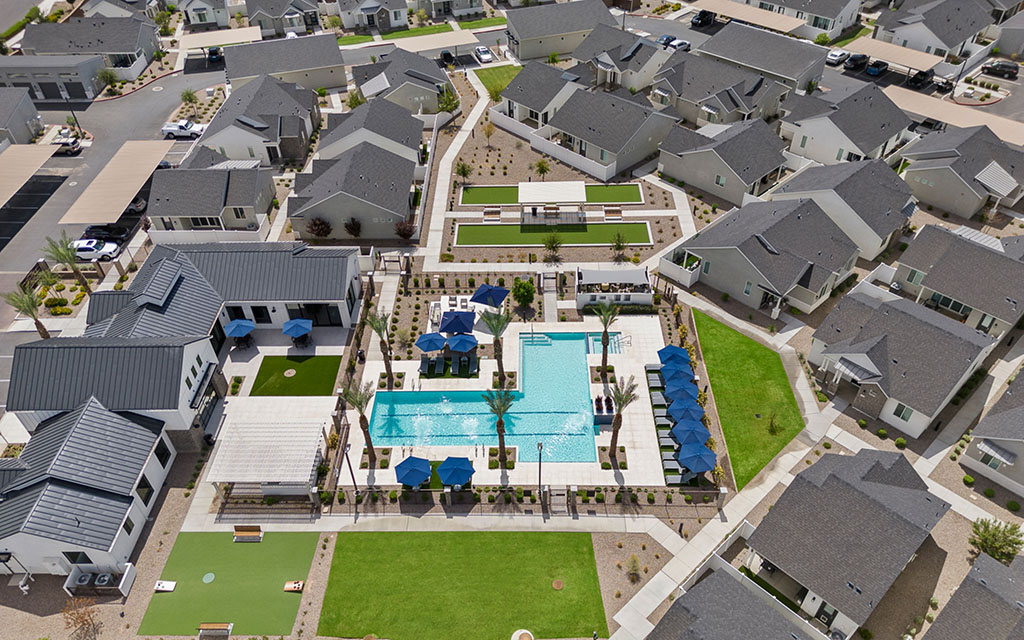
Mark-Taylor’s EVR Spur Cross build-to-rent community is in Queen Creek. (Photo courtesy of Mark-Taylor Investment Management)
PHOENIX – High mortgage interest rates are pushing prospective homebuyers to consider build-to-rent communities instead.
Build-to-rent (BTR) communities with single-family home rentals fill the space between traditional rental properties and housing developments. They are constructed with the renter, not the buyer, in mind, and the target market includes young individuals and those who want a more home-like feel as opposed to an apartment lifestyle.
Rising interest rates are making it difficult for individuals to purchase homes. The Maricopa Association of Governments’ June 2023 housing update identified 256,000 households in the Phoenix metropolitan statistical area as “severely cost-burdened,” meaning they spend more than 50% of their income on housing.
Charlene Deanda is a resident at one of the many BTR communities located in the West Valley. Deanda moved from Texas to Arizona to pursue her college softball career at Ottawa University’s Surprise campus. She attends college and works full time.
When Deanda was apartment searching with her sister, she realized the apartment lifestyle wasn’t for her. Being so far from home, Deanda wanted something homier, roomier and without an upstairs neighbor or having to share close quarters.
She found a gated BTR community in the quiet suburban city of Surprise that checked all the boxes on her list. The community consisted of one- and two-bedroom homes for rent.
“We (Deanda and her sister) wanted something that would feel like home, we could decorate ourselves,” Deanda said. “We wanted something gated to be safe. We wanted to live in a good community.”
Deanda said it would have been costly to live in a regular apartment. Paying $1,800 for a standard apartment or choosing a BTR home with more privacy, safety and convenience for about the same cost was a no-brainer for her. .
She also wouldn’t have to worry about plucking weeds and changing air filters because the community’s maintenance team would handle home repairs and landscaping.
“Any problem you have, they fix it within a day as opposed to if I had a house, I would have to call somebody,” Deanda said.
Having fewer maintenance responsibilities allows Deanda to focus on college and her full-time job. She said this lifestyle ultimately saves her money because she doesn’t have to pay a mortgage or call a repair person on the fly.
A 2023 report from Northmarq, which specializes in commercial real estate, pointed out that Phoenix has been a top market for single-family rentals and “absorption spiked to more than 3,600 units in 2023, doubling the annual average from the preceding five-year period.”
According to the report, the average rent on a single-family, build-to-rent unit in the U.S. is $828 per month lower than the average monthly mortgage payment on a median price single-family home.
Creating diverse options for housing enables people to choose what best suits their lifestyle.
“We meet the needs of many, many different demographics. With the cost to buy homes becoming so high, you’re getting a lot of individuals who are renters by choice instead of being homeowners,” said Kaycee Kisling, managing director of multifamily investments at Mark-Taylor Investment Management.
She said Mark-Taylor has managed over 35 new BTR communities – more than 6,000 units – since 2017. Many BTR communities are being built in the West Valley because the rural landscape provides more room for the communities, she said.

Mark-Taylor’s EVR Spur Cross build-to-rent community has one-, two- and three-bedroom detached homes in Queen Creek. (Photo courtesy of Mark-Taylor Investment Management)
“The cost to buy versus rent in the United States has not been this out of whack in most people’s lifetimes since back to maybe 1980,” Kisling said. “From an economic side, it really serves the needs of a resident that is ready to move into a different phase of life or looking for those levels of comfort. I think we’ll find that a lot of people choose to stay in this product type long term for the conveniences.”
Kisling said in the last economic down cycle, there was a large “shadow market” of homes that were swooped up by investors and rented off-market. Individuals were renting homes in neighborhoods that weren’t professionally managed. As some of those homes turned to foreclosure, it became a “scary prospect to lots of renters.”
In the current economic down cycle, Kisling said Mark-Taylor is avoiding that trend by offering the build-to-rent housing option.
The completion of BTR units increased in 2023, and new construction resulted in higher vacancy rates and a plateau in rental rates. Vacancies in Phoenix ended the third quarter of 2023 at 7.7%, higher than the market’s apartment vacancy rate, according to the Northmarq report.
Though new supply growth is outpacing new demand, single-family homes remain popular with renters.
The Northmarq report expects the BTR property class to remain in “growth mode” into 2024 as the high cost of buying a home continues to push people toward more affordable single-family rentals. Though obtaining financing for future development presents a challenge, projects already underway will significantly boost inventory levels across dozens of markets, according to the report.
While the future of the BTR sector faces some headwinds, Kisling said they are “here to stay.”
“As you get a little more rural or in the urbanizing neighborhoods, it serves the needs of the growing job force that’s out there,” Kisling said. “What you’re seeing along the 303 or on the west side of town – there’s a lot of job growth out there, both on the industrial sector and driven by the continued development of the TSMC (Taiwan Semiconductor Manufacturing Company) plan. So, you’re seeing a lot of this product type (BTR communities) built for that.”
Kisling said the BTR sector is branching outside of Maricopa County, serving communities that are underserved in terms of housing options, such as Casa Grande.
“It will continue to elevate, I think, and become very competitive in meeting the needs of those residents through what amenities it offers,” Kisling said.

